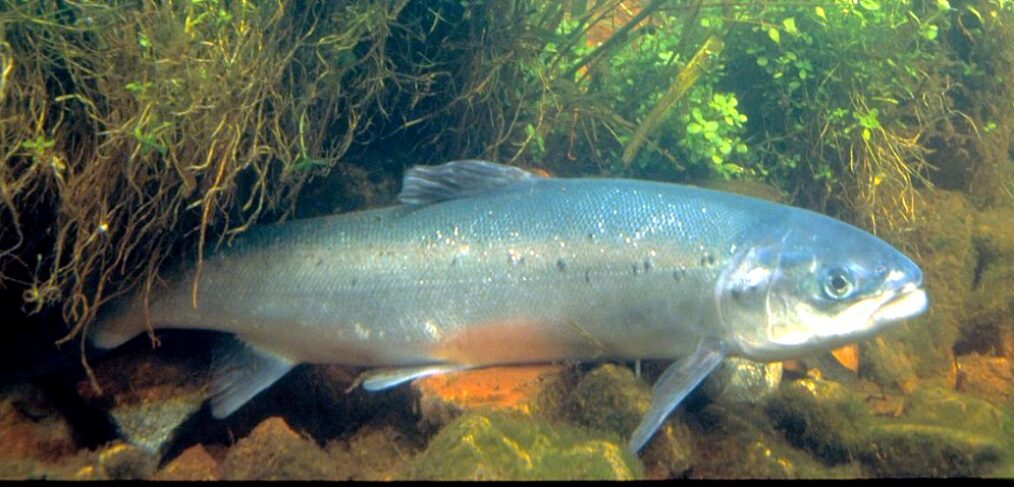
Species of the week #119 – Atlantic salmon
“Salmon? Oh, yummy!” That’s certainly what many people think. But since salmon was the most important species of fish in the Rhine and its tributaries until the end of the 19th century, according to legend, maids refused to take a job until it was guaranteed that there would be food other than salmon. The salmon’s ability to find its way home from the coasts of the North Atlantic and the North Sea to the waters in which it once hatched is also legendary.
| Distribution status in Rhineland-Palatinate | Threatened with extinciton |
| Remaining occurance | Wieslauter, Rhine |
| Last sighting | 2018 |
| Habitat | North Sea and North Atlantic coasts, cool waters with gravelly pits |
| Threat | Development of rivers, climate change |
Salmon grow to an average size of between 50 and 120 cm, in exceptional cases up to 150 cm, and weigh between 20 and 30 kg. Their colour changes from bluish-grey to brownish (females) or rust-red (males) shortly before spawning. Male salmon ready to spawn can also be recognised by their hook-shaped lower jaw.
As migratory fish, salmon spend their growth phase of one to three years in the sea, but migrate back to the rivers in which they hatched to spawn. This obstacle-filled migration takes up to a year. From the beginning of November to the end of February, they reach their spawning grounds in the upper reaches of the rivers. In the clean gravel, the female salmon digs a pit in which she lays the fish eggs. Usually both females and males die immediately after spawning. The delicate fish larvae develop from the eggs after 40 to 200 days. Depending on the region, they remain in freshwater for one to five years before migrating to the sea as young fish.
In Canada, hundreds of thousands of salmon have died in agony in recent weeks due to the persistent drought. And here, too, the rising water temperature is affecting the animals. The returning salmon wait for high water periods to be able to overcome barriers more easily. If these do not materialise, they are forced to spawn in less suitable areas. This leads to a lower probability of survival of the offspring. In the case of Pacific salmon, it has already been observed that the population shifts towards animals that spawn particularly early in the year.
As early as the mid-19th century, it was noticed that salmon stocks continued to decline. In order to secure the supply of salmon, the “Treaty between Germany, the Netherlands and Switzerland, concerning the Regulation of Salmon Fishing in the Rhine River Basin” (so-called Salmon Treaty) was concluded in 1885. However, the agreed protection and fishing rules and the release of hatched salmon larvae had little success. The Trier state fish farm in the Avelsbach valley had to be abandoned in the 1930s due to a lack of fish from which to raise hatchlings.
In 2004, a French-German project for the biological development of the Wieslauter including the reintroduction of salmon began, in which about 200,000 hatchlings were also placed in the Wieslauter by 2017. Similar projects have existed since 1998 on the Sieg, Lahn, Saynbach and Ahr. The goal was to reintroduce salmon at “population level” – i.e. to build up self-sustaining stocks by 2020. Unfortunately, the numbers of salmon returning from the sea are not as high as hoped and the populations are still not stable. To find out which breeding and stocking strategies work, the University of Koblenz-Landau is currently researching genetic monitoring of the few salmon returning. It is hoped that this will provide crucial information on the correct management of salmon programmes.
Tip for those who are already thinking about their next lunch or Christmas menu while reading this: Make sure it’s organic aquaculture salmon and turn salmon from an everyday meal into a special occasion feast.
Policy need:
- Support renaturation research
- Support for renaturation/restoration projects
- Renaturation of water bodies, removal of barriers
- Combating climate change
There are many more Species of the Week- Find out more here.
Photo : By Hartley, William W. – U.S. Fish & Wildlife Service, WO4846-highlights (crop of full image), Public domain, https://commons.wikimedia.org/w/index.php?curid=119106
